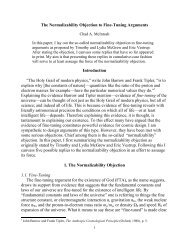Theism and Explanation - Appeared-to-Blogly
Theism and Explanation - Appeared-to-Blogly
Theism and Explanation - Appeared-to-Blogly
You also want an ePaper? Increase the reach of your titles
YUMPU automatically turns print PDFs into web optimized ePapers that Google loves.
Inference <strong>to</strong> the Best <strong>Explanation</strong> 103<br />
claims that positing the existence of God offers us a successful explanation<br />
of various facts about the world. Some of these facts are very general—<br />
such as the very existence of a universe, operating in regular <strong>and</strong> predictable<br />
ways—while others are more particular. The particular facts <strong>to</strong> which<br />
Swinburne appeals have <strong>to</strong> do with the existence <strong>and</strong> nature of human<br />
beings, as well as reports of events in human his<strong>to</strong>ry, some of which he<br />
sees as miracles. Once again, I shall not be examining the soundness of<br />
Swinburne’s arguments. If my argument <strong>to</strong> this point is correct, that would<br />
require a careful case-by-case study. I am happy <strong>to</strong> leave that task <strong>to</strong> others.<br />
All I want <strong>to</strong> do is <strong>to</strong> examine the structure of his arguments, <strong>to</strong> see if that<br />
sheds any light on the questions I am addressing.<br />
6.1.1 Inductive Reasoning<br />
Swinburne consistently claims <strong>to</strong> be offering inductive arguments for the<br />
existence of God. In particular, he claims <strong>to</strong> be offering sound C-inductive<br />
arguments, which he describes as arguments that make the theistic hypothesis<br />
more probable than it would be otherwise. 5 His example of a C-inductive<br />
argument is the following.<br />
(1) All of 100 ravens observed in different parts of the world are black.<br />
(2) [Therefore] all ravens are black. 6<br />
This is certainly an inductive argument, indeed one made famous by Carl<br />
Hempel’s discussion of inductive reasoning (7.1.2). 7 But do Swinburne’s<br />
arguments take this particular form?<br />
They do not. It is true that Swinburne’s arguments are not deductive<br />
arguments; they do not take the form of a syllogism such as the following:<br />
(1) No material body travels faster than light.<br />
(2) My car is a material body.<br />
(3) [Therefore] my car does not travel faster than light. 8<br />
If you defi ne an “inductive argument” as any argument that is not deductive<br />
<strong>and</strong> can support only a probable conclusion, then Swinburne’s arguments<br />
can be described as inductive. But they are not inductive in the sense<br />
in which such arguments were unders<strong>to</strong>od by John Stuart Mill <strong>and</strong> his<br />
successors. 9 In discussions of scientifi c reasoning, an inductive argument<br />
is one that proceeds from the observation of particulars <strong>to</strong> the formation<br />
of a general hypothesis. 10 The principle underlying such reasoning may be<br />
summarised as follows.<br />
If a large number of As have been observed under a wide variety of conditions,<br />
<strong>and</strong> if all those observed As without exception have possessed<br />
the property b, then all As possess the property b. 11



